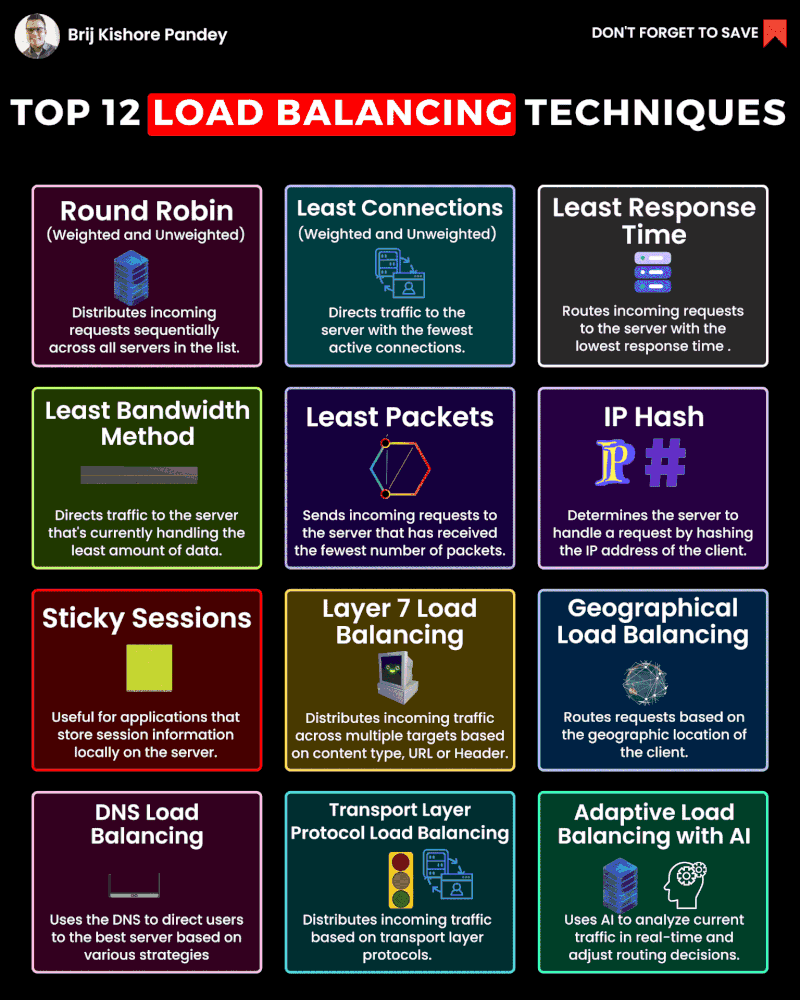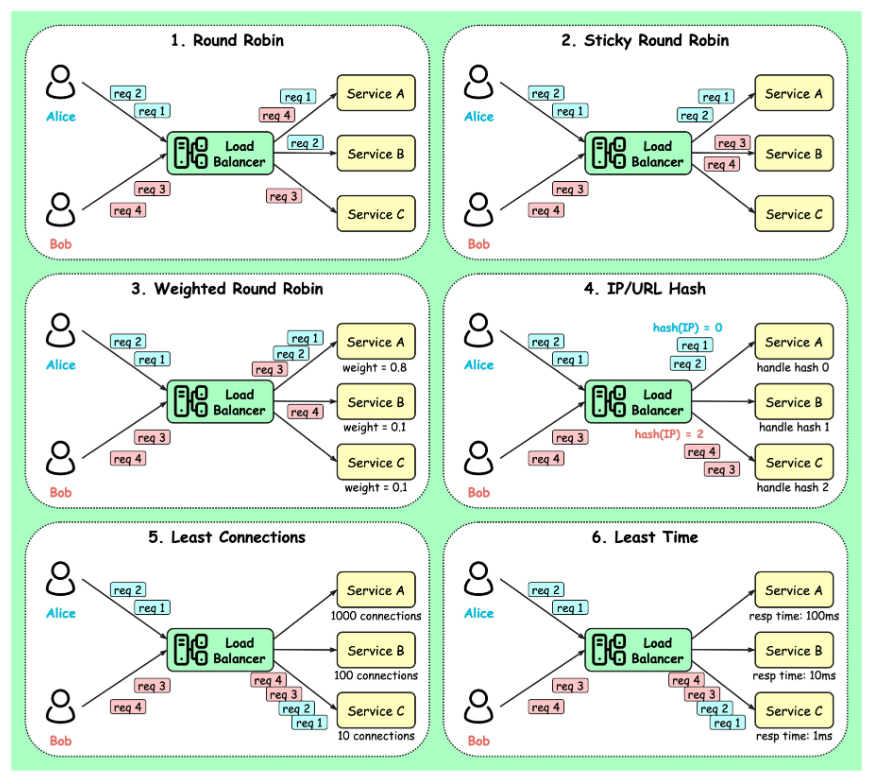
Load balancing techniques are essential for distributing network traffic across multiple servers to ensure optimal performance, high availability, and reliability. Here is a list of popular load balancing techniques:
- Round Robin:
- Requests are distributed to servers in a circular order.
- Simple and easy to implement.
- Doesn’t consider server load or health.
- Least Connections:
- Traffic is sent to the server with the fewest active connections.
- Distributes load based on server capacity.
- Requires constant monitoring of active connections.
- Least Response Time:
- Traffic is sent to the server with the shortest response time.
- Prioritizes faster servers to improve user experience.
- Weighted Round Robin:
- Servers are assigned different weights based on their capacity.
- Higher-weighted servers receive more traffic.
- Useful when servers have varying performance capabilities.
- Weighted Least Connections:
- Similar to weighted round robin, but based on active connections.
- Servers with lower active connections receive more traffic.
- IP Hash:
- Uses a hash function based on the client’s IP address to determine the server.
- Provides session persistence for the same client.
- Random:
- Traffic is directed to a randomly selected server.
- Simple but doesn’t consider server load or capacity.
- Chaffing and Winnowing:
- Authenticates clients by sending a mix of valid and invalid requests.
- Used for security purposes to prevent unauthorized access.
- Content-based Routing:
- Routes traffic based on specific content attributes (e.g., URL, HTTP headers).
- Useful for directing traffic to specialized servers.
- URL Hashing:
- Hashes the URL of the request to determine the server.
- Ensures that requests for the same URL are consistently sent to the same server.
- Geographic Load Balancing:
- Routes traffic based on the geographic location of the client.
- Improves performance by directing users to the nearest server.
- DNS Load Balancing:
- Distributes traffic by modifying DNS responses to point to different IP addresses.
- Can distribute load across multiple data centers.
- Anycast:
- Routes traffic to the closest server in terms of network hops.
- Used for high availability and redundancy.
- Layer 4 Load Balancing:
- Operates at the transport layer (TCP/UDP) and forwards traffic based on IP and port.
- Efficient for distributing network traffic.
- Layer 7 Load Balancing:
- Operates at the application layer (HTTP) and distributes traffic based on application-specific attributes.
- Offers more advanced routing capabilities.

here is a comparison of all load balancing techniques:
| Load Balancing Technique | Description | Pros | Cons |
|---|---|---|---|
| Round robin | This is the simplest load balancing technique. It distributes traffic evenly across all servers in the pool. | Simple to implement and manage. | Does not take into account the health of the servers. |
| Weighted round robin | This is a variation of round robin that allows you to assign weights to servers. This means that some servers can receive more traffic than others. | Can be used to balance traffic based on the capacity of the servers. | More complex to implement and manage than round robin. |
| Least connections | This technique distributes traffic to the server with the fewest connections. This can help to improve performance by ensuring that no server is overloaded. | Can help to prevent overloading of servers. | Does not take into account the health of the servers. |
| Least response time | This technique distributes traffic to the server with the shortest response time. This can help to improve performance by ensuring that users experience the shortest possible wait times. | Can help to improve user experience. | More complex to implement and manage than least connections. |
| Hashing | This technique distributes traffic based on a hash of the request. This can help to ensure that requests are distributed evenly across the servers, even if the number of servers changes. | Can help to distribute traffic evenly across servers. | More complex to implement and manage than round robin. |
| Least bandwidth | This technique distributes traffic to the server with the least bandwidth utilization. This can help to prevent overloading of servers. | Can help to prevent overloading of servers. | Does not take into account the health of the servers. |
| Least latency | This technique distributes traffic to the server with the least latency. This can help to improve user experience. | Can help to improve user experience. | More complex to implement and manage than least connections. |
The best load balancing technique for a particular application will depend on the specific requirements of that application.
Here are some additional considerations when choosing a load balancing technique:
- The number of servers: The number of servers in the pool will affect the performance of the load balancer. A larger pool of servers can handle more traffic, but it can also be more expensive.
- The type of traffic: The type of traffic will also affect the performance of the load balancer. Some load balancing techniques are better suited for certain types of traffic than others.
- The budget: The cost of the load balancer will also be a consideration. Some load balancing techniques are more expensive than others.
- The need for scalability: If the application needs to be able to scale to handle more traffic, then a load balancer that can be scaled up or down is needed.
- The need for security: If the application needs to be secure, then a load balancer that can provide security features is needed.
I’m a DevOps/SRE/DevSecOps/Cloud Expert passionate about sharing knowledge and experiences. I am working at Cotocus. I blog tech insights at DevOps School, travel stories at Holiday Landmark, stock market tips at Stocks Mantra, health and fitness guidance at My Medic Plus, product reviews at I reviewed , and SEO strategies at Wizbrand.
Please find my social handles as below;
Rajesh Kumar Personal Website
Rajesh Kumar at YOUTUBE
Rajesh Kumar at INSTAGRAM
Rajesh Kumar at X
Rajesh Kumar at FACEBOOK
Rajesh Kumar at LINKEDIN
Rajesh Kumar at PINTEREST
Rajesh Kumar at QUORA
Rajesh Kumar at WIZBRAND

 Starting: 1st of Every Month
Starting: 1st of Every Month  +91 8409492687
+91 8409492687  Contact@DevOpsSchool.com
Contact@DevOpsSchool.com
